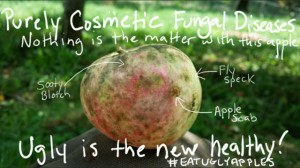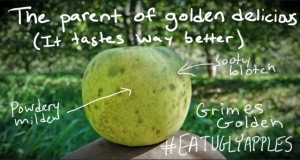When you walk through the produce section of a grocery store, it’s always the same view once you get to the apples. Large, glistening orbs of pristine red, yellow and green apples are neatly piled on the shelves, their looks alone inviting the shopper to add them to their cart. So you pick one up and scrupulously examine it to make sure nothing is wrong, add it to your cart, and move on with your purchases. As an apple grower in Southwestern Virginia, I’d like to use four words to tell you what I think about these pristine apples at the grocery store: I won’t eat them.
It’s not just because they often taste bad (Red delicious – seriously?), but also because how they are grown. You see, that pristine, blemish-free beauty is a result of management – apples do not naturally look like that in Virginia. Left to its own devices on a tree (and it depends on the apple variety), an apple would likely be covered in a smattering of cosmetic diseases. These diseases do not alter the taste of these apples (aside from sometimes making them sweeter) and are not in any way an indicator of your apple having a worm. Yet we Americans have been trained to eat beautiful fruit and reject the blemishes. Because we fear these harmless blemishes, millions of gallons of fungicides are sprayed on apples (organic and conventional) every year across the United States to make them go away.
That person on the tractor in a white tyvec suit who is being followed by a white plume of chemical spray – that’s me, Eliza Greenman, age 30. No matter how much I try and cover-up with all of the necessary gear, I get those chemicals on me at a higher concentration than what lands on the fruit. I’m one of the youngest orchardists in the country by a generation and hope to have a long life ahead of me so I’ve started a campaign to reduce the threats on my health as the farmer, your health as the consumer, and the environmental impacts from farming practices. Eat Ugly Apples.

Making the conscious choice to eat ugly apples is better and cheaper for you as the consumer, protects environmental quality and it’s better for me as the farmer. It’s time we challenged the social norm that currently has us demanding glistening orbs of perfection from the growers. This takes some awareness and I’m here to help.
Good to Do:
- Consider eating varieties of apples that you’ve never heard of before. There are 7,000 different known varieties of apples in North America and many of these are better suited for growing in the hot and humid Virginia climate. For example, apples called “Russets” look like potatoes and aren’t very susceptible to many of the cosmetic diseases. They taste amazing. Ask for them and keep asking for them!
- Learn the blemishes. I’m convinced that corporate agriculture named these diseases to sound much worse than they actually are. Sooty blotch, fly speck, apple scab and powdery mildew are the top four cosmetic diseases. My pictures above should help you identify them.
- Spread the ugly apple gospel! Bring down those naysayers with assurance that they will not get sick from eating sooty blotch or fly speck. Naysayers still rejecting the blemishes? Peel it!
- Take ugly apples social! Tweet, Facebook and Instagram the handle #eatuglyapples when consuming a beautifully blemished specimen. Let’s get this out there.
Thank you, and may you have many ugly apples in your future!
Eliza is an orchardist and tree nursery owner in Southwestern VA (originally from Poquoson, VA). She specializes in growing heirloom apples, cultivating rare apple genetics, and raising fruit trees for the hard cider industry.

